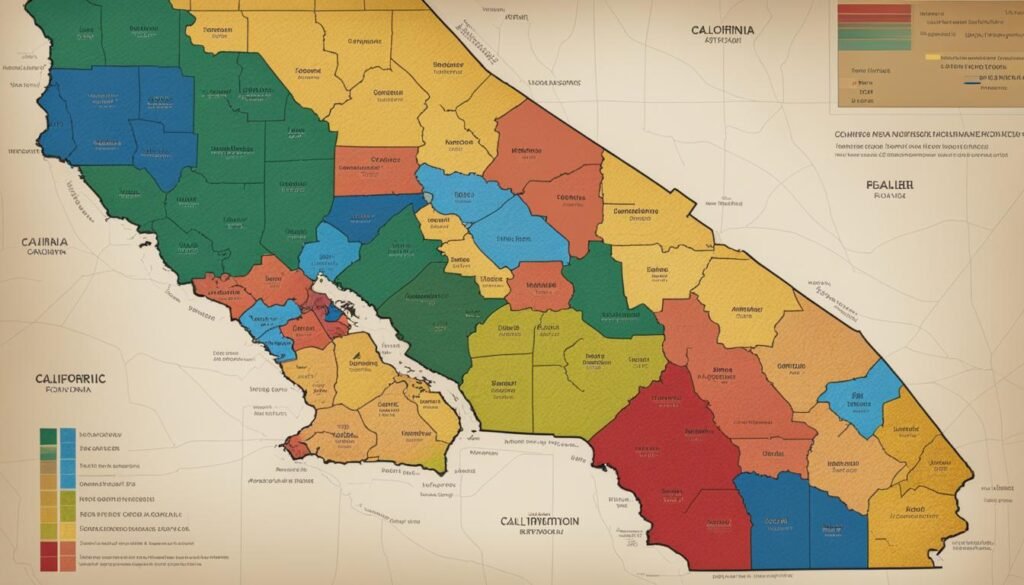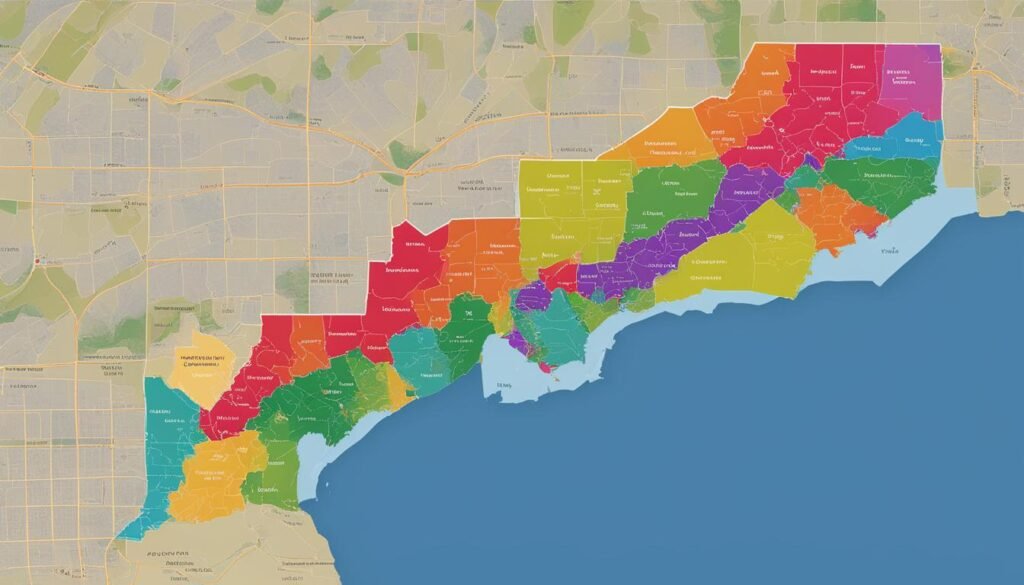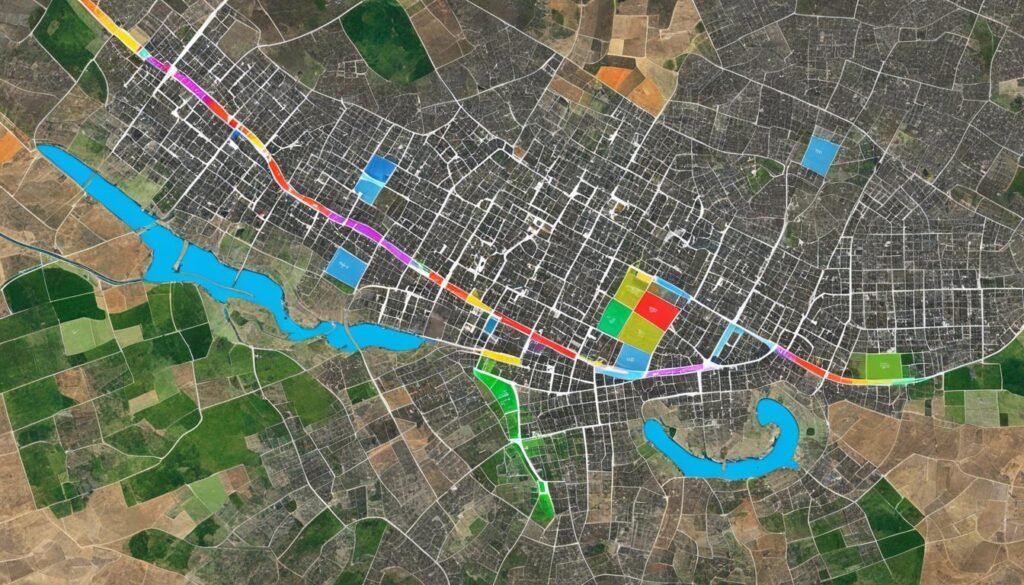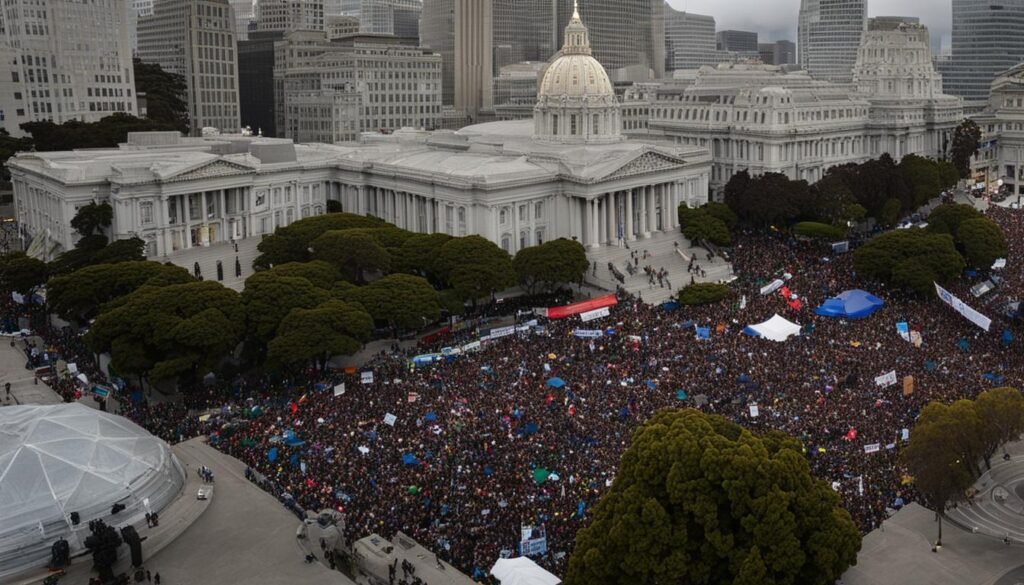California redistricting is a crucial process that shapes political boundaries and ensures fair representation for voters. As the most populous state in the United States, California’s redistricting efforts have significant implications for the distribution of political power.
The redistricting process in California involves the careful redrawing of district lines based on various criteria. This process encompasses both legislative and congressional redistricting, and maps are used to visualize these changes. It aims to create districts that accurately reflect the state’s diversity and demographics, and to prevent gerrymandering, the manipulation of district boundaries for political gain.
California has a citizen redistricting commission, composed of individuals selected through an application process. This commission ensures fairness and impartiality in the redistricting process, and follows a timeline that allows for transparency and public input.
Key Takeaways:
- California redistricting determines political boundaries and ensures fair representation for voters.
- The redistricting process involves the creation of new assembly and congressional districts.
- Maps are used to visualize the redrawing of district lines.
- Gerrymandering is a common concern in redistricting.
- California has a citizen redistricting commission to ensure fairness and prevent political manipulation.
Understanding the Redistricting Process in California
When it comes to redistricting in California, there are two main components: legislative redistricting and congressional redistricting. The purpose of redrawing the district lines is to account for changes in population and ensure that each district has equal representation.
The redistricting process, also known as redrawing district lines, involves analyzing demographic data and considering various factors such as communities of interest and minority representation. This ensures that the new districts accurately reflect the diversity and needs of the population.
To establish guidelines and criteria for the redistricting process, redistricting legislation is passed. This legislation serves as a framework to guide the redrawing of district lines and promote fairness.
Additionally, a redistricting timeline is followed, which outlines key dates and milestones for public input and map creation. This allows for transparency and ensures that the process includes input from the community.
Overall, understanding the redistricting process is crucial to ensuring fair representation for all Californians. By considering various factors and following a clear timeline, the redrawing of district lines can accurately reflect the changes in population and provide equal representation.

The Role of the Redistricting Commission
California’s redistricting process is overseen by a citizen redistricting commission. This commission, composed of citizens selected through an application and selection process, plays a crucial role in redrawing district lines. Its primary objective is to ensure fair and impartial redistricting, free from political bias.
The redistricting commission takes into consideration a variety of criteria when redrawing district lines. One important factor is maintaining communities of interest, ensuring that individuals with common characteristics or concerns are grouped together in the same district. This approach allows for better representation and ensures that the unique needs of different communities are taken into account.
Another key consideration for the commission is respecting geographic boundaries. By aligning district lines with natural and man-made boundaries, such as rivers or highways, the commission aims to create districts that make sense geographically and promote more cohesive representation.
The goal of the redistricting commission is to create districts that accurately reflect the diversity and demographics of the state. By considering factors such as population size, racial and ethnic makeup, and socio-economic indicators, the commission strives to ensure that all communities have a fair and equitable voice in the political process.

Impact on Congressional and Assembly Districts
California redistricting plays a significant role in shaping the boundaries of both congressional and assembly districts. Through the redrawing of district lines, changes can occur that directly impact the representation of voters in these districts. Let’s take a closer look at some of the effects of redistricting on these important political entities:
Changes to CA-13 District Boundaries
One potential outcome of the redistricting process is the modification of the boundaries of the CA-13 district. As district lines are redrawn based on population changes and demographic shifts, the boundaries of CA-13 may be adjusted to ensure fair representation and equal voter voice. These changes can have significant implications for the constituents and political landscape within the district.
Creation of New Assembly Districts
Population changes and demographic shifts can also lead to the creation of new assembly districts during the redistricting process. As California’s population evolves, the need to accurately represent its diverse communities becomes crucial. By establishing new assembly districts, the redistricting process aims to provide fair and effective political representation for all residents.
Impact on Bay Area Congressional Districts
Redistricting decisions can also impact the congressional districts within the Bay Area. The redrawing of district lines may result in changes that influence the political dynamics and representation within the affected districts. As the boundaries of Bay Area congressional districts are adjusted, it is important to consider the potential impact on voter representation and the distribution of political power.
Overall, California redistricting holds the power to shape the voter landscape by defining the boundaries of congressional and assembly districts. It ensures that the interests and concerns of the state’s residents are accurately represented within the political system. The redistricting process is vital for maintaining fair and effective voter representation while accounting for the evolving demographic and population trends in the state.

Addressing Gerrymandering in California
Gerrymandering is an issue that plagues the redistricting process, and California is no exception. It involves the manipulation of district boundaries for political gain, resulting in districts that are skewed and non-competitive. The negative effects of gerrymandering undermine fair representation and can lead to disenfranchisement of certain groups of voters.
However, California has taken significant steps to address this concern. The state has established a transparent and citizen-led redistricting commission to oversee the redrawing of district boundaries. This commission is designed to prevent partisan manipulation and ensure a fair representation of the electorate.
By removing the power from politicians and placing it in the hands of citizens, California’s redistricting commission aims to promote fairness and eliminate gerrymandering. This approach empowers the public to have a voice in the redistricting process and serves as a safeguard against political bias.
The commission utilizes a transparent and inclusive process that allows for public input and scrutiny. Through public hearings and soliciting feedback from community members, the commission ensures that the interests and concerns of the public are taken into account when redistricting decisions are made.
California’s commitment to addressing gerrymandering sets an example for other states grappling with this issue. By prioritizing fair representation over partisan advantage, the state is driving positive change in the political redistricting landscape.
The Significance of Addressing Gerrymandering
- Ensures fair and equal representation for all voters
- Preserves the integrity of the democratic process
- Prevents political manipulation of district boundaries
- Promotes competitive elections and robust democracy
- Increases trust and confidence in the electoral system
Transparency and Public Input in the Redistricting Process
In the redistricting process in California, transparency and public input play a vital role in ensuring a fair and inclusive process. The redistricting commission understands the importance of involving the public and actively seeks input from community members through public hearings and feedback sessions. This ensures that the redrawing of district lines takes into account the interests and concerns of the people, ultimately leading to fair representation.
One of the key components of transparency is the redistricting timeline. This timeline outlines specific dates for public input and map creation, providing an opportunity for the public to actively participate in shaping the new district boundaries. By including a clear timeline, the redistricting process becomes more transparent, and accountability is fostered.
Redistricting legislation also plays a crucial role in promoting transparency and public input. These laws provide guidelines for public participation and establish mechanisms for citizens to voice their opinions. Redistricting legislation ensures that the process remains fair, inclusive, and free from any biased manipulation.
By including the public in the redistricting process, California aims to create districts that accurately reflect the diverse demographics and interests of its residents. With transparency and public input, the redistricting commission strives to minimize gerrymandering and promote fair representation for all.
Text with bolded keywords:
In the redistricting process in California, transparency and public input play a vital role in ensuring a fair and inclusive process. The redistricting commission understands the importance of involving the public and actively seeks input from community members through public hearings and feedback sessions. This ensures that the redrawing of district lines takes into account the interests and concerns of the people, ultimately leading to fair representation.
One of the key components of transparency is the redistricting timeline. This timeline outlines specific dates for public input and map creation, providing an opportunity for the public to actively participate in shaping the new district boundaries. By including a clear timeline, the redistricting process becomes more transparent, and accountability is fostered.
Redistricting legislation also plays a crucial role in promoting transparency and public input. These laws provide guidelines for public participation and establish mechanisms for citizens to voice their opinions. Redistricting legislation ensures that the process remains fair, inclusive, and free from any biased manipulation.
By including the public in the redistricting process, California aims to create districts that accurately reflect the diverse demographics and interests of its residents. With transparency and public input, the redistricting commission strives to minimize gerrymandering and promote fair representation for all.
Mapping the Future: California Redistricting Maps
California redistricting maps play a crucial role in illustrating the changes to district boundaries resulting from the redistricting process. These maps provide a visual representation of the new assembly districts and potentially affected bay area congressional districts. With these maps, stakeholders can easily comprehend how district lines have been redrawn and gain a deeper understanding of the impact on their respective areas and communities.
These detailed and informative maps enable a clear visualization of the evolution of district boundaries. They serve as valuable resources for individuals and organizations seeking to participate actively in the redistricting discussions and understand how the new CA assembly districts and bay area congressional districts will be shaped.
Conclusion
In conclusion, the redistricting process in California is a crucial and intricate undertaking that shapes district boundaries and ensures equitable representation for voters. The process involves redrawing district lines for both legislative and congressional districts to reflect changes in population and maintain fairness. The redistricting commission plays a pivotal role in promoting a transparent and unbiased process.
Transparency and public input are essential components of California’s redistricting process. Through public hearings and soliciting feedback, the commission ensures that the interests and concerns of the public are considered when redrawing district lines. This inclusivity fosters a system that prioritizes the representation of diverse communities and prevents partisan manipulation of boundaries.
Mapping the new district boundaries is crucial to understanding the impact of redistricting. California redistricting maps provide a visual representation of how district lines have been redrawn, allowing stakeholders to comprehend the changes and their implications for their respective areas and communities. These maps help facilitate a transparent and informed dialogue among citizens, elected officials, and community organizations.
Ultimately, the redistricting process in California strives to minimize gerrymandering and promote fair representation. By adhering to principles of transparency, public input, and the use of maps, California aims to create a democratic system where every vote counts and every voice is heard.
FAQ
What is redistricting?
Redistricting is the process of redrawing district boundaries to account for changes in population and ensure equal representation.
What is the redistricting process in California?
The redistricting process in California involves both legislative and congressional redistricting, with the goal of creating fair and impartial districts.
Who is responsible for redistricting in California?
California has a citizen redistricting commission that is responsible for redrawing district lines, ensuring fairness and free from political bias.
How does gerrymandering impact redistricting in California?
Gerrymandering is a concern in the redistricting process, but California has taken steps to address it by establishing a transparent and citizen-led commission.
How does the redistricting process ensure transparency and public input?
The redistricting process in California involves public hearings and soliciting feedback to ensure transparency and incorporate public input.
How are congressional and assembly districts affected by redistricting?
Redistricting can result in changes to congressional and assembly district boundaries, impacting voter representation and political dynamics.
How are California redistricting maps used?
California redistricting maps visually depict the changes to district boundaries, helping stakeholders understand the impact on their communities.







